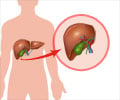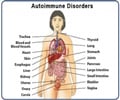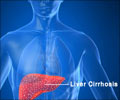Estrogen and a signaling molecule called interleukin-6 collude to form a powerful duo that prompts immune cell misconduct and fuels autoimmune liver damage that affects women more than men.

The findings, the research team says, also suggest therapeutic strategies to curb damage in people who develop drug-induced liver inflammation.
"Our study shows that estrogen is not alone in its mischief but working with an accomplice to set off a cascade of events that leads to immune cell dysregulation and culminates in liver damage," says Dolores Njoku, M.D., a pediatric anesthesiologist and critical care expert at Johns Hopkins Children's Center.
In the study, led by Njoku, researchers induced liver inflammation in mice by injecting them with drug-derived haptens. Female mice developed worse liver damage than male mice, and castrated male mice fared worse than their intact brethren, likely due to loss of testosterone and altered estrogen-to-testosterone ratio, the researchers say. Female mice with missing ovaries — the chief estrogen-secreting organs — suffered milder forms of hepatitis than mice with intact ovaries.
Female mice produced more liver-damaging antibodies and more inflammation-triggering chemicals, specifically the inflammatory molecule interleukin-6, known to fuel autoimmunity. Liver damage was notably milder in female mice whose interleukin-6 receptors were blocked or missing compared with normal female mice. On the other hand, male mice and female mice with missing ovaries had nearly undetectable levels of interleukin-6, while castrated male mice showed simultaneous upticks in both estrogen and interleukin-6.
The research team further zeroed in on a class of cells known as regulatory T cells, whose main function is keeping tabs on other immune cells to ensure they don't turn against the body's own tissues. When researchers compared the number of regulatory T cells present in the spleens of male and female mice, they noticed far fewer regulatory T cells in the spleens of female mice. The spleen, the researchers explain, is the primary residence of mature immune cells.
In a final, dot-connecting move, the researchers immersed spleen-derived immune cells in estrogen. What they observed proved beyond doubt that estrogen, interleukin and regulatory T cells form a powerful triangle. Estrogen induced the immune cells of female mice to express more interleukin-6, which in turn diminished the expression of inflammation-taming regulatory T cells.
This powerful response, the researchers say, suggests that therapy with regulatory T cells may reduce estrogen-related liver damage in patients with autoimmune hepatitis. Such treatment, however, remains years away from human application.
One reason, the researchers say, is that regulatory T cells maintain the fine equilibrium between overactive and underactive immunity. Because an overactive immune system can lead to autoimmune diseases and an underactive one can promote tumor growth, any therapy with regulatory T cells must be precisely calibrated to avoid tipping this precarious balance.
"We first must figure out where the golden mean lies," Njoku says.
Source-Eurekalert
 MEDINDIA
MEDINDIA




 Email
Email










